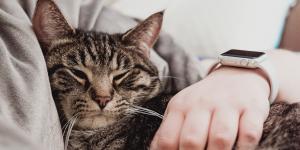Why do Cats Rub Against Your Legs?



See files for Cats
Many feline behaviors make sense from a human perspective. The way they wolf down their food, curl up in a cosy ball or even purr in delight all seem reasonable to us. Walking in between our legs as if to trip us up or rubbing against us doesn't seem to be quite as understandable. When we guess reasons for this feline behavior, it is easy to interpret it incorrectly. Some people see it as a pleasant greeting similar to that of a dog. Others see it as an invitation to be petted. While there may be some truth to these interpretations, we need to dig a little deeper to get a full explanation.
In this AnimalWised article, we answer the question why do cats rub against your legs? If you want to understand the reasons behind this behavior and improve the bond with your cat in the process, keep reading.
Reasons why cats rub against our legs
Before we go into detail about the reasons cats walk between our legs and rub against them, we want to provide a summary of them. Cats may rub against your legs because they are:
- Marking their territory
- Displaying affection
- Sending signals to themselves and other cats
- Stress (only with excessive rubbing)
- Showing appreciation
To better understand these behaviors, keep reading below.
My cat walks between my legs
When cats rub against our legs, we may interpret this as their own version of petting. While cats won't use their paws as we do our hands, it might make sense they would try to reciprocate our affection. From our human perspective, it makes sense that cats manifest their affection in this way. Unfortunately, we too often apply human behaviors to animals which do not share them. Feline communication does not work in the same way.
The movement cats make when they rub between our legs should be interesting to us. Their ritual usually starts by rubbing the side of their head against our ankles. They then follow with their flanks rubbing between our legs and then finish by curling their tail. Most commonly this behavior will be accompanied by purring or even a little tremor in the tail.
To best understand what the cat is trying to do, we need to know the cat isn't trying to ‘pet’ us. It is important to distinguish that rubbing against us is more important than going between our legs. The reason they are walking between our legs is simply the fact they are smaller than us and can do so. If you pay attention to the cat's behavior, you will see that they rub against many different people, animals and even objects in the home.

My cat rubs against by legs
As we have seen, when the cat rubs against our legs they tend to use their whole body. This is because cats have scent glands on their cheeks, chins, the pads of their feet, their back and even the base of their tail. These glands are pretty much imperceptible underneath their fur, but their anal glands and genitals also perform a similar function. When these glands are stimulated, they secrete pheromones which are unique to the individual cat.
Although we may not be able to perceive their scent due to our comparatively poor olfactory senses, cats are much more acute when it comes to smell. Their more developed sense allows them to send signals to other cats and animals. In fact, from birth, the cat's sense of smell is their first form of contact with the outside world since kittens are born deaf and blind.
During this process, the cats use their vomeronasal organ, also known as their Jacobson's organ. This is a tiny duct located between their palate and nasal passages. This organ is present in only some animal species and contains specialized cells which can better sense chemicals in their environment such as pheromones. They process this important olfactory information and send them to the brain.
When a cat rubs against you, whether between your legs or not, they are actually marking you with their scent. They are communicating to both you and others that you are part of their social group. From a human perspective this may seem strangely possessive, but for felines it is an important act which helps them to know who they can trust.
You may experience a cat headbutting you in the legs or other body parts. There are similar reasons behind this behavior which are explain in our article on why cats headbutt you.
Why do cats have the need to mark their territory?
Our feline companions are usually very meticulous when it comes to ensuring their environment is secure. They have a serious need to feel comfortable and protected. If they do not, their security is threatened and they can develop serious stress and anxiety issues. By marking their territory with their scent they do two things. Firstly, they can use it to know which areas are safe for them. They also warn other cats they are entering into another cat's territory.
When you get home from a vacation, you might see that the cat rubs against your legs when they first see you. The cat is imbuing you with the scent they recognize. We can also see that feline pheromones are transmitted in other ways. These include mutual grooming and licking, something which helps to indicate membership of the same family or group.
Marking is, therefore, an indication of well-being. The behavior shows that the cat feels comfortable in their environment, as well as among the objects, animals and people therein. Even small changes can threaten the cat's sense of security. For example, if you replace some old furniture, moved home or had an addition to the family, the cat may stop their marking behavior. You may see them seek refuge or hide away from people. On the other hand, it is also important to recognize excessive marking as it may be a sign of stress.
Finally, we must always remain alert when we observe marking behavior which is out of the ordinary. You should also look for other signs of behavioral problems such as excessive meowing, urinating outside their litter box, biting or other anti-social behavior. If we cannot pinpoint the reason why they are exhibiting behavioral problems, we should take them to a veterinarian to rule out a physical problem. They can then suggest an ethologist to understand any psychological issues at play.

Is a cat rubbing against your legs a sign of affection?
When a cat rubs against your legs, they are marking you. However, it is not simply a sign they consider you their ‘property’ as we humans may understand. This rubbing is a clear indication they love you. Since you are the person who provides them with all of their daily needs in the form of security, food, comfort, etc., they develop a bond of trust.
Cats can also show affection to strangers. Some cats are very skittish and will run away at the sound of a knock or doorbell. If you walk in to your friend's home and the cat starts rubbing against you legs and walking between them, they are clearly showing acceptance of you in their territory. This is a similar behavior as when they roll over and expose their belly to us.
Finally, another reason why the cat is rubbing against you is to alert you to something. One major example is that they may be hungry, so they are telling you they need their bowl filled up. It is not unreasonable to see that since you respond to leg rubbing by petting them or giving them attention, they will understand that this habit elicits certain actions from us. This is part of the all-important communication we have with our cat.
When we actually do fill up their bowl, the cat will often rub against our legs with more intensity. They may even walk through our legs so much, they make it hazardous. This is another sign of affection, but can almost be seen as a kind of ‘thank you’ or display of happiness.
If your cat rubs against your legs, as long as it is not an indication of stress, it is a very positive thing. It proves your bond is strong and there is affection between you.

If you want to read similar articles to Why do Cats Rub Against Your Legs?, we recommend you visit our Facts about the animal kingdom category.
- Ellis, S., Rodan, I., Carney, H. Heath, S., Rochlitz, I. Shearbur, L. Sundahl, E & Westropp, J. (2013). AAFP and ISFM guidelines on feline environmental needs. Journal of Feline Medicine and Surgery. 15, 219-230.
- Turner, D. (2013). The Domestic Cat: The Biology of its Behavior . 3rd ed. Cambridge University Press.
- Stella, J., Croney, C., Buffington, T. (2013). Effects of stressors on the behavior and physiology of domestic cats. Journal of Applied Animal Behavior Science. 143, 157-163.







